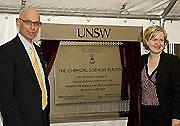Chemical Sciences Building -- official opening
It's official. UNSW's new Chemical Sciences Building and Analytical Centre is open for business.
It's official. UNSW's new Chemical Sciences Building and Analytical Centre is open for business.

It's official. UNSW's new Chemical Sciences Building and Analytical Centre is open for business.
NSW Minister for Science and Medical Research, The Hon Verity Firth, MP opened the new facility during a ceremony attended by UNSW Vice Chancellor Professor Fred Hilmer, Deputy Vice Chancellor (Research) Professor Les Field, Science Dean, Professor Mike Archer and Associate Prof Barbara Messerle, Head of the School of Chemistry.
The new building houses world-class teaching, research and laboratory facilities, including the Electron Microscope Unit, the Bioanalytical Mass Spectrometry Facility, the Nuclear Magnetic Resonance Facility, and the Solid State & Elemental Analysis Unit.
The Analytical Centre houses a host of vital instrumentation used by science, medical and engineering researchers studying the structure and composition of biological, chemical and physical materials. For example, researchers from UNSW's Brain Sciences Group and the Prince of Wales Medical Research Institute are using high-resolution NMR spectroscopy to better understand the biochemical basis for brain function and disease.
The Centre's bioanalytical mass spectrometer is being used in proteomics research aimed at understanding the function of proteins in inflammatory diseases such as osteoarthritis, atherosclerosis and psoriasis.
Engineering research supported by the Centre includes development of next generation solar power devices and specialist polymers for biomaterial applications - research that relies on access to the latest techniques in solid state and surface analysis and electron microscopy.
Staff at the Analytic Centre have strong relationships with affiliated research groups and external research facilities, and each of the Centre's major research units offer specialist consulting and general analytical services to external clients. The Centre has about 1,000 research users, including many postgraduate and honours students.